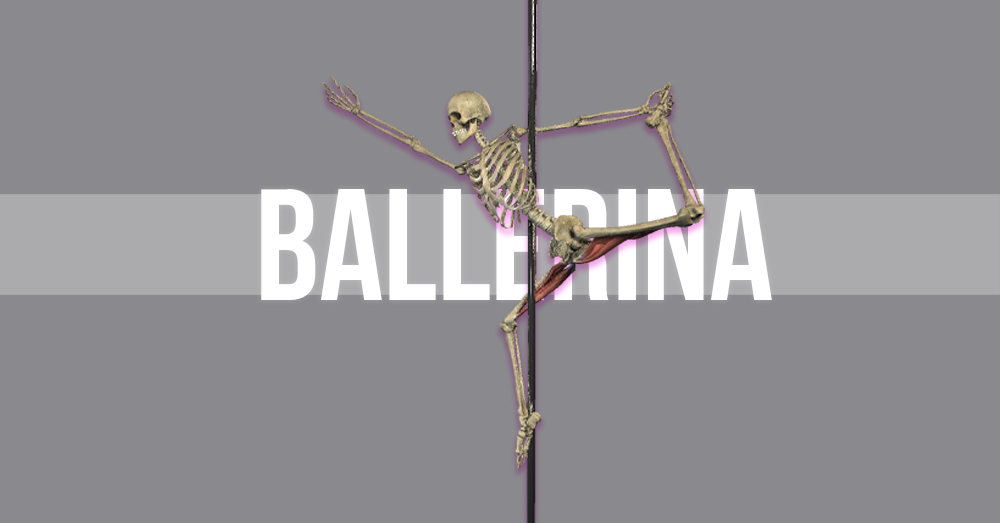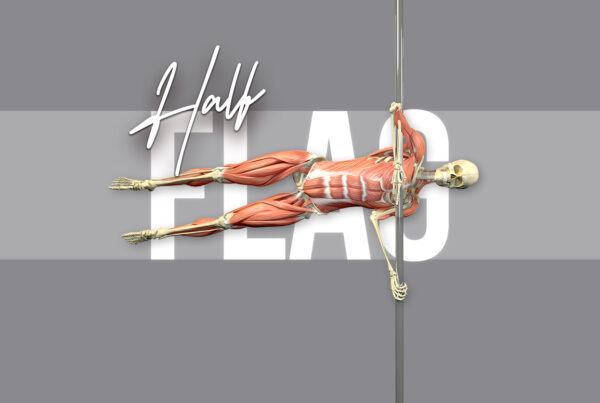If you’re currently on ‘Mission Ballerina’, exploring the ins and outs and trying to figure this one out – I have a tip for you…
READY FOR MY BIG BALLERINA TIP? *insert drum roll*
Don’t forget to check in on your pelvis and hip positioning!
Huh? But isn’t the pole ballerina all about spinal rotation?
Yup! Thoracic rotation and shoulder mobility are both key for the Ballerina. Pssst… if you want to look at the different elements of the Ballerina, I did a post about that a while back: Anatomy of the Twisted Ballerina!
But that’s not what I want to talk about today!
Did you know that increasing the range of motion through your hips might just open up the extra wiggle room you need to perform this move more comfortably and consistently, without overreliance on end-range spinal rotation?
…and I’m not even talking about that back leg!
Pole dance ballerina positioning
Let’s put the other elements of the Ballerina aside, just for a moment. Indulge me. And let’s zone-in on that inside leg.
Rather watch than read? You can see a video explanation of the key points of this blog post in this bite-sized <90 second, ‘made for social media’ whistle-stop tour of a vid featuring awkward self-promotion by me at the end:
Side note: My ‘short-form’ content game is getting pretty strong, huh? I’m trying my best to be the snappy, knowledge-bomb-dropping social media node that the world of reels and #fitness demands of me, but it’s hard when there is just SO MUCH juicy detail to discuss!
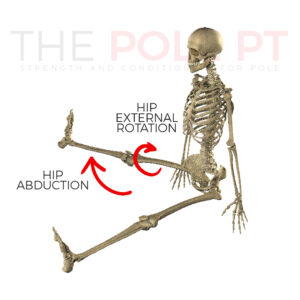
Anyway, as I was saying… if we have good strength and mobility in the two movements shown above (hip abduction and external rotation), it means we’ll be able to rotate our pelvis more in the ‘transverse’ plane – which will then reduce the amount of spinal rotation and shoulder extension needed.
Here’s a little visual for you, courtesy of our most excellent Pole Dancing Skelly:
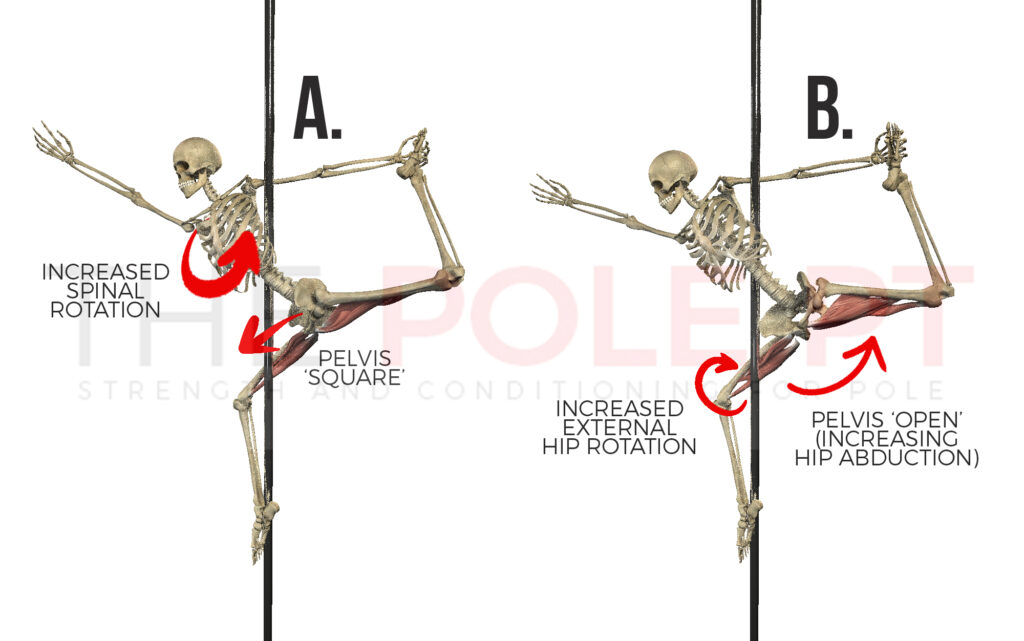
I’ve exaggerated the difference here so you can see clearly the distinction between the two positions, but hopefully this allows you to see how hip mobility in abduction and external rotation can impact the position of the pelvis – and how this plays a role in the ballerina position. Pretty cool, hey?
PS If you want to get even more techy about it, note how the position of the pelvis has an impact on the back leg positioning, too. In position A, the back leg will be in increased extension (and usually in slight external rotation), whereas in position B, the leg will move more towards abduction and internal rotation. Again, this position is exaggerated in the image below for the purposes of this demonstration!
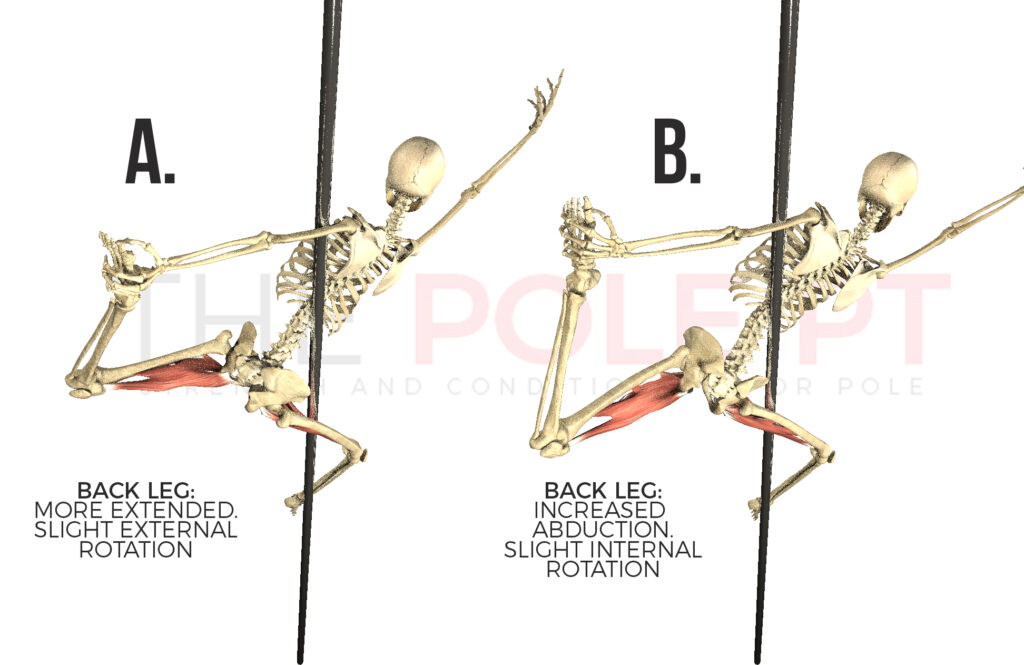
Whether you tend to sway more towards a column ‘A’ or a column ‘B’ Ballerina will depend on your own strength, mobility and engagement in the trick.
It’s why your Ballerina probably looks different to my Ballerina – and every other #pdballerina on Instagram!
While it’s great to play to our strengths, IMO a good goal is to try and spread the load of pole tricks like this across the different joints involved, rather than relying on an extreme range of motion in one particular area.
That means if you have a good, solid level of strength and mobility in all the key areas required for this trick (thoracic rotation, shoulder extension, hip abduction, hip flexion, hip rotation annnd hip extension – phew, that’s quite a wish list!) it’s going to put you in the best place to be able to achieve this move on the pole!
But if you’re struggling to rotate and make contact with your back leg in your Ballerina, and you know your spinal rotation, shoulder mobility and hip extension are on point – maybe it’s time to explore other, less obvious areas that might be holding you back, like your hip abduction and hip rotation mobility!
This is the joy of the Anatomy of Pole – understanding the different elements of a trick so you can direct your training for it where you need it most.
Okay, so how do I improve hip abduction and rotation mobility for the pole dance ballerina?
When I talk about ‘strength and mobility’ in hip abduction and external rotation, what I really mean is flexibility in the hip adductors (inner thigh muscles) and strength in the hip abductors (primarily gluteus medius, AKA Side Butt) and external hip rotators.
In my next blog post, I’ll share some of my go-to exercises for doing just that!
In the meantime, if you want to nerd out with me a bit more, my book Pole Anatomy is available in paper copy or immediate digital download and comes with over 60 interactive 3D models, so you can see all the moves covered in the book from all angles! It’s full of little anatomy insights just like the one in this post, which might just help you understand and unlock those nemesis pole tricks you’ve been hankering after.


